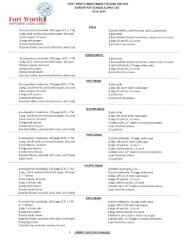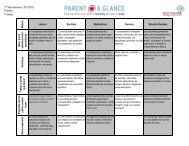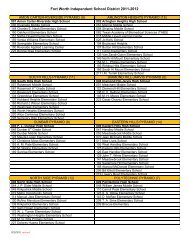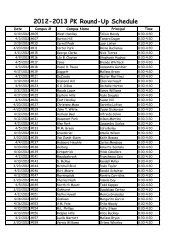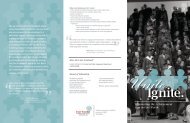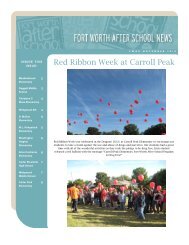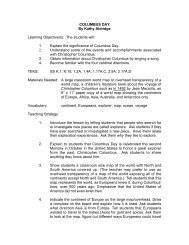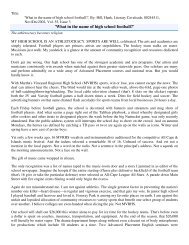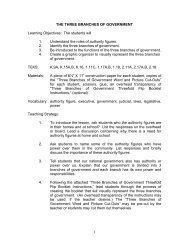Bulletin One 2012 2013 Final.pdf - Fort Worth ISD
Bulletin One 2012 2013 Final.pdf - Fort Worth ISD
Bulletin One 2012 2013 Final.pdf - Fort Worth ISD
You also want an ePaper? Increase the reach of your titles
YUMPU automatically turns print PDFs into web optimized ePapers that Google loves.
Unhealthy for<br />
Sensitive<br />
Groups<br />
101-150 Orange When AQI values are between 101 and 150, members of<br />
sensitive groups may experience health effects. This means<br />
they are likely to be affected at lower levels than the general<br />
public. For example, people with lung disease are at greater<br />
risk from exposure to ozone, while people with either lung<br />
disease or heart disease are at greater risk from exposure to<br />
particle pollution. The general public is not likely to be<br />
affected when the AQI is in this range.<br />
Unhealthy 151-200 Red Everyone may begin to experience health effects when AQI<br />
values are between 151 and 200. Members of sensitive<br />
groups may experience more serious health effects.<br />
Very<br />
Unhealthy<br />
201-300 Purple AQI values between 201 and 300 trigger a health alert,<br />
meaning everyone may experience more serious health<br />
effects.<br />
Hazardous 300+ Maroon AQI values over 300 trigger health warnings of emergency<br />
conditions. The entire population is more likely to be<br />
affected.<br />
*Sensitive groups are defined as children who are active in outdoor activities, people involved in highenergy<br />
activities, and people with respiratory ailments. Students with respiratory limitations should follow<br />
the advice of a doctor or guardian. FW<strong>ISD</strong>’s Ozone Policy Plan is not to restrict sensitive adults from<br />
these activities, but is a plan of action in which information is provided for their use to determine whether<br />
or not it is advisable for them to perform these activities in conjunction with FW<strong>ISD</strong> scheduled activities.<br />
3.15.II Ozone Action Policy<br />
Each parent or legal guardian of a child sensitive to ozone must have a statement from a physician on file<br />
at the school campus stating such. Parents or legal guardians must make the decision on a daily basis if<br />
their children should be allowed to participate in outside activities, they must send in writing a note<br />
requesting their child be kept in for that day due to ozone levels. (If there is not a doctor’s statement on<br />
file the child will not be kept inside.) Each day is a new day and must be treated as such.<br />
School principals may make morning ozone announcements.<br />
In addition to this information, each teacher, coach or instructor of outside activities should perform the<br />
following:<br />
Pre-screen their classes for individuals who have sensitivities to ozone conditions as described<br />
in the previous table. This may include a questionnaire or a permission slip from the parent<br />
and/or physician (similar to a sport’s permission).<br />
Become aware of possible atmospheric conditions and develop their outside activities in<br />
conjunction with the Health Services designated person.<br />
Have and alternative plan for a cancelled outside activity. FW<strong>ISD</strong> employees shall try to fuel<br />
their vehicles in the morning when possible. FW<strong>ISD</strong> employees shall not perform any duties<br />
that would add to the levels of ozone on high ozone days if possible. It shall be the<br />
responsibility of each campus to initiate and operate this plan. Any ozone or heat related<br />
injuries or episodes are to be immediately reported to the Health Services Department.<br />
12-13 SY <strong>Bulletin</strong> Number <strong>One</strong> 58 Revised: 10/9/<strong>2012</strong>





